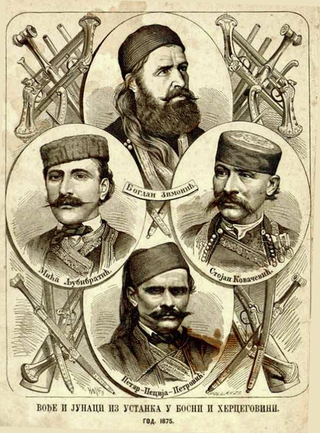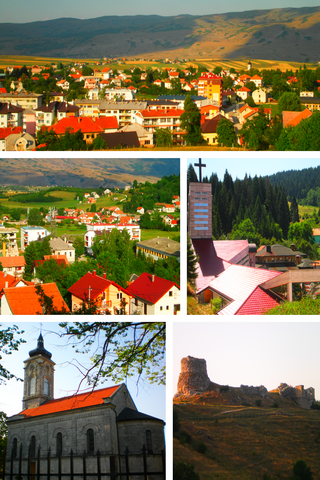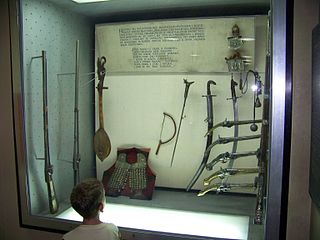
The Herzegovina uprising was an uprising led by the Christian Serb population against the Ottoman Empire, firstly and predominantly in Herzegovina, from where it spread into Bosnia and Raška. It broke out in the summer of 1875, and lasted in some regions up to the beginning of 1878. It was followed by the Bulgarian Uprising of 1876, and coincided with Serbian-Turkish wars (1876–1878), all of those events being part of the Great Eastern Crisis (1875–1878).

Canton 10 or Herzeg-Bosnian Canton is the largest of the cantons of the Federation of Bosnia and Herzegovina by area and eighth by population. The local government seat is in Livno, while the assembly is in Tomislavgrad.

Bosansko Grahovo is a town and municipality located in Canton 10 of the Federation of Bosnia and Herzegovina, an entity of Bosnia and Herzegovina. It is situated in western Bosnia and Herzegovina along the border with Croatia.

Bosanska Krajina is a geographical region, a subregion of Bosnia, in western Bosnia and Herzegovina. It is enclosed by a number of rivers, namely the Sava (north), Glina (northwest), Vrbanja and Vrbas. The region is also a historic, economic and cultural entity of Bosnia and Herzegovina, famous for its natural beauties and wildlife diversity.

Gradiška, formerly Bosanska Gradiška, is a city and municipality located in the northwestern region of Republika Srpska, the entity of Bosnia and Herzegovina. As of 2013, it has a population of 51,727 inhabitants, while the city of Gradiška has a population of 14,368 inhabitants.

The Serbs of Bosnia and Herzegovina are one of the three constitutive nations of the country, predominantly residing in the political-territorial entity of Republika Srpska. They are frequently referred to as Bosnian Serbs in English, regardless of whether they are from Bosnia or Herzegovina.

Drvar is a town and municipality located in Canton 10 of the Federation of Bosnia and Herzegovina, an entity of Bosnia and Herzegovina. The 2013 census registered the municipality as having a population of 7,036. It is situated in western Bosnia and Herzegovina, on the road between Bosansko Grahovo and Bosanski Petrovac, also near Glamoč.

Glamoč is a town and municipality located in Canton 10 of the Federation of Bosnia and Herzegovina, an entity of Bosnia and Herzegovina. It is situated in southwestern Bosnia and Herzegovina, at the foothills of Staretina and Velika Golija mountains, and on the edge of the central part of the Glamoč Field. The municipality encompasses the town of Glamoč as a seat of the municipality and more than 50 villages and hamlets situated along the Field. It mainly covers an area of the historical and geographical region of Tropolje.
Petar Mrkonjić was a legendary hajduk from the Imotski region in the Dalmatian Hinterland, in modern-day Croatia, active during the Cretan War (1645–1669) between the Republic of Venice and Ottoman Empire as a guerrilla leader serving Venice.

Petar Popović, known as Pecija (Пеција), was a Serb hajduk (brigand) and rebel leader in two uprisings against the Ottoman Empire in the Bosanska Krajina region, one in 1858, and one in 1875.

Bogdan Zimonjić, was a Serbian Orthodox priest and Vojvoda in two major uprisings against the Ottoman Empire in 19th-century Herzegovina: in 1852–62, and 1875–78. He is mentioned in archival sources along with other Serbian freedom-fighting priests, including Jovica Ilić and his associates Pavle Tvrtković, Mile Vitković, and Stevan Avramović, who rebelled against the occupiers, and another priest, Petko Jagodić of Šamac, who led the next revolt, while history records further armed clashes led by priests Mile Čulibrk, Marko Popović, Vaso Kovačević, and Gaćina.

Uroš Drenović was a Bosnian Serb military commander in the central Bosnia region of the fascist puppet state known as the Independent State of Croatia (NDH), led by the Ustaše, during World War II. After distinguishing himself in resisting the Ustaše alongside communist-led rebels, Drenović betrayed the communist-led Partisans and began to collaborate with the Ustaše, Italians and Germans against them.

Pecija's First Revolt or Doljani Revolt was an uprising in Knešpolje led by Serb hayduk leader Petar Popović–Pecija (1826–1875) against the Ottoman government, that extended over the period of June—December 1858. It was a result of pressure against the local Serb populace, with past atrocities conducted by the Ottomans.

The Serbian hajduks were brigands (bandits) and guerrilla freedom fighters (rebels) throughout Ottoman-held Balkans, mainly in Serbia, organized into bands headed by a harambaša, who descended from the mountains and forests and robbed and attacked the Ottomans. They were often aided by foreign powers, such as the Republic of Venice and Habsburg monarchy, during greater conflicts.

The Serb uprising of 1596–1597, also known as the Herzegovina uprising of 1596–1597, was a rebellion organized by Serbian Patriarch Jovan Kantul and led by Grdan, the vojvoda ("duke") of Nikšić against the Ottomans in the Sanjak of Herzegovina and Montenegro Vilayet, during the Long Turkish War (1593–1606). The uprising broke out in the aftermath of the failed Banat Uprising in 1594 and the burning of Saint Sava's relics on 27 April 1595; it included the tribes of Bjelopavlići, Drobnjaci, Nikšić, and Piva. The rebels, defeated at the field of Gacko in 1597, were forced to capitulate due to a lack of foreign support.
A massacre of Croat civilians was committed by local Serb rebels on 27 July 1941 in village Trubar in Drvar municipality Independent State of Croatia. It was one of a number of massacres in the southwestern Bosnian Krajina during the Drvar uprising and Eastern Lika.
Sulejman Pasha of Uskoplje was an Ottoman Bosnian military commander and governor active in Rumelia, who distinguished himself fighting Serb rebels in the 1800s and 1810s. He served as the first Vizier of Belgrade after crushing the First Serbian Uprising (1804–1813).

The Drvar uprising was the World War II uprising of the Serb population of Bosnian Krajina. Italy supported it, both politically and in arms, in its struggle against the fascist puppet state of the Independent State of Croatia between 27 July and 26 September 1941.















